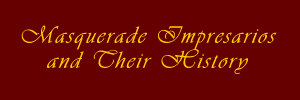

The tradition of masquerades was introduced to English society from Italy "where it had evolved from a carnival practice by the Swiss Count, John James Heidegger, who had arrived in England in 1708" [1]. Count Heidegger sponsored the first masquerade ball at the Haymarket Opera House [2]. The phenomenon became a trend throughout London, but Count Heidegger was the leading impresario of masquerades in the early part of the eighteenth century. In the second half of the century, Heidegger was succeeded by Mrs. Theresa Cornelys, a Venetian born opera singer, actress and adventuress [3]. Her subscription masquerades were held mostly at Carlisle House in Soho Square, starting in 1763 [4].
"To acknowledge the role of impresarios like Heidegger is not, however, to settle entirely the matter of origins. For we are left with the event itself, which though encouraged and to some degree institutionalized by the promoters, was not wholly created by them. The English masquerades of the eighteenth century had the shape, from one angle, of a business enterprise, and were part of the new capitalist world of public entertainment that was coming into being. But however commercialized and stylized they became, they were always something else too. Above all, they were a vestige of the ancient and powerful world of carnival" [5].
Endnotes
1. Ribiero, Aileen. The Dress Worn at Masquerades in England 1730 to 1790.
New York, NY:
Garland Published, 1984, 3.
2. Ribiero, 3.
3. Castle, Terry. Masquerade and Civilization: the Carnivalesque in Eighteenth-Century
English
Culture and Fiction. Stanford, CA: Stanford University
Press, 1986, 10.
4. Ribiero, 14.
5. Castle, 11.